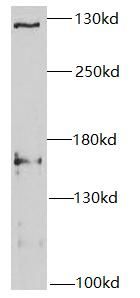Products
SETD2 antibody
| Synonyms: | Histone-lysine N-methyltransferase SETD2|HIF-1|Huntingtin yeast partner B|Huntingtin-interacting protein 1 (HIP-1)|Huntingtin-interacting protein B|Lysine N-methyltransferase 3A|Protein-lysine N-methyltransferase SETD2|SET domain-containing protein 2 (hSET2)|p231HBP|SETD2|HIF1|HYPB|KIAA1732|KMT3A|SET2 antibody | ||
| Catalogue No.: | FNab07767 | Reactivity: | Human, Mouse, Rat |
| Host: | Rabbit | Tested Application: | ELISA, WB, IHC, IF |
| Clonality: | polyclonal | Isotype: | IgG |
| Size | Price |
|---|---|
| 100µg | Inquiry |
- SPECIFICATIONS
- FIGURES
- CONDITIONS
- FAQS
- Product Name
- SETD2 antibody
- Catalogue No.
- FNab07767
- Size
- 100μg
- Form
- liquid
- Purification
- Immunogen affinity purified
- Purity
- ≥95% as determined by SDS-PAGE
- Clonality
- polyclonal
- Isotype
- IgG
- Storage
- PBS with 0.02% sodium azide and 50% glycerol pH 7.3, -20℃ for 12 months(Avoid repeated freeze / thaw cycles.)
- Immunogen
- SET domain containing 2
- Alternative Names
- Histone-lysine N-methyltransferase SETD2|HIF-1|Huntingtin yeast partner B|Huntingtin-interacting protein 1 (HIP-1)|Huntingtin-interacting protein B|Lysine N-methyltransferase 3A|Protein-lysine N-methyltransferase SETD2|SET domain-containing protein 2 (hSET2)|p231HBP|SETD2|HIF1|HYPB|KIAA1732|KMT3A|SET2 antibody
- UniProt ID
- Q9BYW2
- Observed MW
- 287 kDa
- Tested Applications
- ELISA, WB, IHC, IF
- Recommended dilution
- WB: 1:500-1:2000; IHC: 1:20-1:200; IF: 1:10-1:100
 H460 cells were subjected to SDS PAGE followed by western blot with FNab07767(SETD2 antibody) at dilution of 1:1000
H460 cells were subjected to SDS PAGE followed by western blot with FNab07767(SETD2 antibody) at dilution of 1:1000
 Immunohistochemistry of paraffin-embedded rat brain tissue slide using FNab07767(SETD2 Antibody) at dilution of 1:50
Immunohistochemistry of paraffin-embedded rat brain tissue slide using FNab07767(SETD2 Antibody) at dilution of 1:50
 Immunofluorescent analysis of HepG2 cells using FNab07767 (SETD2 antibody) at dilution of 1:50 and Rhodamine-Goat anti-Rabbit IgG
Immunofluorescent analysis of HepG2 cells using FNab07767 (SETD2 antibody) at dilution of 1:50 and Rhodamine-Goat anti-Rabbit IgG
- Background
- Histone methyltransferase that specifically trimethylates 'Lys-36' of histone H3(H3K36me3) using dimethylated 'Lys-36'(H3K36me2) as substrate. Represents the main enzyme generating H3K36me3, a specific tag for epigenetic transcriptional activation. Plays a role in chromatin structure modulation during elongation by coordinating recruitment of the FACT complex and by interacting with hyperphosphorylated POLR2A. Acts as a key regulator of DNA mismatch repair in G1 and early S phase by generating H3K36me3, a mark required to recruit MSH6 subunit of the MutS alpha complex: early recruitment of the MutS alpha complex to chromatin to be replicated allows a quick identification of mismatch DNA to initiate the mismatch repair reaction. H3K36me3 also plays an essential role in the maintenance of a heterochromatic state, by recruiting DNA methyltransferase DNMT3A. H3K36me3 is also enhanced in intron-containing genes, suggesting that SETD2 recruitment is enhanced by splicing and that splicing is coupled to recruitment of elongating RNA polymerase. Required during angiogenesis. Recruited to the promoters of adenovirus 12 E1A gene in case of infection, possibly leading to regulate its expression.
How many times can antibodies be recycled?
First, usually it's not suggested to recycle antibodies. After use, buffer system of antibodies has changed. The storage condition of recycled antibodies for different customers also varies. Thus, the performance efficiency of recycled antibodies can’t be guaranteed. Besides, FineTest ever conducted the antibody recycling assay. Assay results show recycling times of different antibodies also varies. Usually, higher antibody titer allows more repeated use. Customers can determine based on experimental requirements.
Notes: After incubation, we recycle rest antibodies to centrifuge tube and store at 4℃. High titer antibodies can be stored for a minimum of one week. Reuse about three times.
What are components of FineTest antibody buffer?
Components of FineTest antibody buffer are usually PBS with proclin300 or sodium azide, BSA, 50% glycerol. Common preservative is proclin300 or sodium azide, which is widely applied in the lab and industry.
How about the storage temperature and duration of FineTest antibodies?
Most antibodies are stored at -20℃. Directly-labeled flow cytometry antibodies should be stored at 2 - 8℃. The shelf life is one year. If after sales issues for purchased antibodies appear, return or replacement is available. Usually, antibodies can be still used after the one-year warranty. We can offer technical support services.
Is dilution required for FineTest antibodies? What’s the dilute solution?
Directly-labeled flow cytometry antibodies are ready-to-use without dilution. Other antibodies are usually concentrated. Follow the dilution ratio suggested in the manual. Dilute solution for different experiments also varies. Common antibody dilution buffers are acceptable(e.g. PBST, TBST, antibody blocking buffer).
How to retrieve antibodies for immunohistochemistry?
Common retrieval buffers: Tris-EDTA Buffer(pH 9.0); Citrate Buffer(pH 6.0)
Heat induced antibody retrieval:
Method 1: Water-bath heating: Put the beaker with retrieval buffer and slide in the boiling water bath. Keep the boiling state for 15min. Naturally cool to room temperature;
Method 2: Microwave retrieval: Put the beaker with retrieval buffer and slide in the microwave oven. Heat at high power for 5min, Switch OFF for 3min, Heat at medium power for 5min. Naturally cool to room temperature.
How to choose secondary antibodies?
(1) Secondary antibodies react with primary antibodies. Thus, secondary antibodies should be against host species of primary antibodies. E.g. If the primary antibody is derived from rabbit, the relevant secondary antibody should be against rabbit. E.g. goat anti rabbit or donkey anti rabbit.
(2) Choose secondary antibody conjugates according to the experimental type, e.g. ELISA, WB, IHC etc. Common enzyme conjugated secondary antibodies are labelled by HRP, AP etc. Fluorescin or dye labelled secondary antibodies are applied in immunofluorescence and flow cytometry(e.g. FITC, Cy3).
